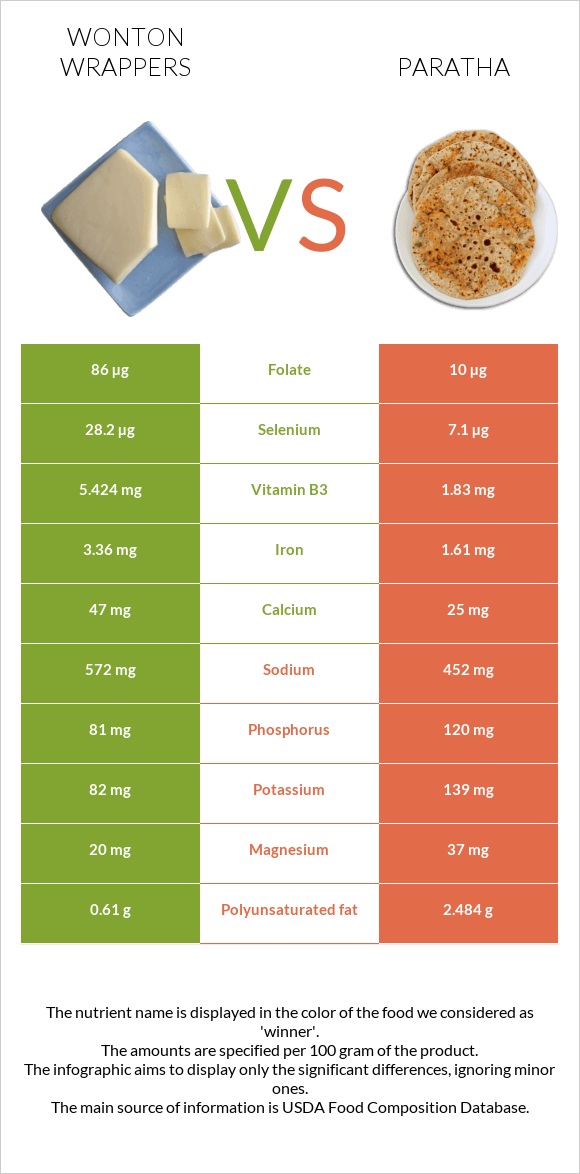Wonton wrappers vs. Paratha — In-Depth Nutrition Comparison
Compare
The main differences between wonton wrappers and paratha
- Wonton wrappers are richer in selenium, vitamin B1, vitamin B2, vitamin B3, iron, and folate, yet paratha is richer in fiber, manganese, and vitamin B5.
- Daily need coverage for selenium for wonton wrappers is 38% higher.
- Wonton wrappers contain 9 times more folate than paratha. Wonton wrappers contain 86µg of folate, while paratha contains 10µg.
- Wonton wrappers contain less saturated fat.
- Paratha has a lower glycemic index than wonton wrappers.
Food types used in this article are Wonton wrappers (includes egg roll wrappers) and Bread, paratha, whole wheat, commercially prepared, frozen.
Infographic

Infographic link
Mineral Comparison
Mineral comparison score is based on the number of minerals by which one or the other food is richer. The "coverage" charts below show how much of the daily needs can be covered by 300 grams of the food.
| Contains more CalciumCalcium | +88% |
| Contains more IronIron | +108.7% |
| Contains more SeleniumSelenium | +297.2% |
| Contains more MagnesiumMagnesium | +85% |
| Contains more PotassiumPotassium | +69.5% |
| Contains more ZincZinc | +15.5% |
| Contains more PhosphorusPhosphorus | +48.1% |
| Contains less SodiumSodium | -21% |
| Contains more ManganeseManganese | +65.2% |
Vitamin Comparison
Vitamin comparison score is based on the number of vitamins by which one or the other food is richer. The "coverage" charts below show how much of the daily needs can be covered by 300 grams of the food.
| Contains more Vitamin AVitamin A | +100% |
| Contains more Vitamin B1Vitamin B1 | +371.8% |
| Contains more Vitamin B2Vitamin B2 | +397.4% |
| Contains more Vitamin B3Vitamin B3 | +196.4% |
| Contains more Vitamin B12Vitamin B12 | +∞% |
| Contains more FolateFolate | +760% |
| Contains more Vitamin B5Vitamin B5 | +1760% |
| Contains more Vitamin B6Vitamin B6 | +166.7% |
All nutrients comparison - raw data values
| Nutrient |  |
 |
DV% diff. |
| Selenium | 28.2µg | 7.1µg | 38% |
| Vitamin B1 | 0.519mg | 0.11mg | 34% |
| Fiber | 1.8g | 9.6g | 31% |
| Saturated fat | 0.263g | 5.826g | 25% |
| Vitamin B2 | 0.378mg | 0.076mg | 23% |
| Iron | 3.36mg | 1.61mg | 22% |
| Vitamin B3 | 5.424mg | 1.83mg | 22% |
| Folate | 86µg | 10µg | 19% |
| Fats | 1.5g | 13.2g | 18% |
| Manganese | 0.638mg | 1.054mg | 18% |
| Starch | 31.5g | 13% | |
| Polyunsaturated fat | 0.61g | 2.484g | 12% |
| Vitamin E | 1.35mg | 9% | |
| Vitamin B5 | 0.025mg | 0.465mg | 9% |
| Monounsaturated fat | 0.195g | 3.837g | 9% |
| Protein | 9.8g | 6.36g | 7% |
| Phosphorus | 81mg | 120mg | 6% |
| Sodium | 572mg | 452mg | 5% |
| Carbs | 57.9g | 45.35g | 4% |
| Magnesium | 20mg | 37mg | 4% |
| Vitamin B6 | 0.03mg | 0.08mg | 4% |
| Cholesterol | 9mg | 1mg | 3% |
| Vitamin K | 3.4µg | 3% | |
| Calories | 291kcal | 326kcal | 2% |
| Calcium | 47mg | 25mg | 2% |
| Potassium | 82mg | 139mg | 2% |
| Zinc | 0.71mg | 0.82mg | 1% |
| Vitamin B12 | 0.02µg | 0µg | 1% |
| Choline | 6.3mg | 1% | |
| Net carbs | 56.1g | 35.75g | N/A |
| Sugar | 4.15g | N/A | |
| Copper | 0.147mg | 0.146mg | 0% |
| Vitamin A | 4µg | 2µg | 0% |
| Trans fat | 0.034g | N/A | |
| Tryptophan | 0.114mg | 0% | |
| Threonine | 0.268mg | 0% | |
| Isoleucine | 0.369mg | 0% | |
| Leucine | 0.684mg | 0% | |
| Lysine | 0.204mg | 0% | |
| Methionine | 0.176mg | 0% | |
| Phenylalanine | 0.486mg | 0% | |
| Valine | 0.417mg | 0% | |
| Histidine | 0.209mg | 0% | |
| Fructose | 0.35g | 0% | |
| Omega-3 - DHA | 0.001g | 0g | N/A |
| Omega-3 - ALA | 0.064g | N/A | |
| Omega-3 - Eicosatrienoic acid | 0.003g | N/A | |
| Omega-6 - Gamma-linoleic acid | 0.006g | N/A | |
| Omega-6 - Eicosadienoic acid | 0.002g | N/A | |
| Omega-6 - Linoleic acid | 2.386g | N/A |
Macronutrient Comparison
Macronutrient breakdown side-by-side comparison
Protein:
9.8 g
Fats:
1.5 g
Carbs:
57.9 g
Water:
28.8 g
Other:
2 g
Protein:
6.36 g
Fats:
13.2 g
Carbs:
45.35 g
Water:
33.5 g
Other:
1.59 g
| Contains more ProteinProtein | +54.1% |
| Contains more CarbsCarbs | +27.7% |
| Contains more OtherOther | +25.8% |
| Contains more FatsFats | +780% |
| Contains more WaterWater | +16.3% |
Fat Type Comparison
Fat type breakdown side-by-side comparison
Saturated fat:
Sat. Fat
0.263 g
Monounsaturated fat:
Mono. Fat
0.195 g
Polyunsaturated fat:
Poly. Fat
0.61 g
Saturated fat:
Sat. Fat
5.826 g
Monounsaturated fat:
Mono. Fat
3.837 g
Polyunsaturated fat:
Poly. Fat
2.484 g
| Contains less Sat. FatSaturated fat | -95.5% |
| Contains more Mono. FatMonounsaturated fat | +1867.7% |
| Contains more Poly. FatPolyunsaturated fat | +307.2% |




